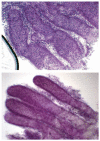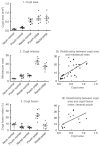The role of cell proliferation and crypt fission in adenoma aggressiveness: a comparison of ileoanal pouch and rectal adenomas in familial adenomatous polyposis
- PMID: 20002690
- PMCID: PMC4610058
- DOI: 10.1111/j.1463-1318.2009.02159.x
The role of cell proliferation and crypt fission in adenoma aggressiveness: a comparison of ileoanal pouch and rectal adenomas in familial adenomatous polyposis
Abstract
Aim: In patients with familial adenomatous polyposis (FAP), ileoanal pouch cancer is rare whereas rectal cancer is common, despite polyp initiation at the two sites being similar at the molecular level. This study investigated whether the disparity in adenoma aggressiveness reflects underlying differences in histogenesis.
Method: Normal mucosal biopsies and 2-3 mm adenomas from patients with FAP were dissected into individual crypts. Crypt area, morphology, fission and mitoses were analysed for crypts from pouch, rectum and supra-anastomotic ileum. Immunohistochemistry of similar archival samples was performed for lysozyme, β-catenin and TP53 expression.
Results: The morphology of normal crypts was similar at each site, although crypt area differed. The area of normal pouch crypts was intermediate between rectum and ileum. The area of adenomatous crypts of rectum and pouch was similar, but the latter had increased asymmetrical fission. Crypt mitoses were proportional to area in all tissues, but crypt fission was reduced in adenomatous crypts from the rectum compared with the pouch. Pouch adenomas retained lysozyme expression as seen in normal ileum. Nuclear β-catenin accumulation was similar, but TP53 expression was increased in rectal adenomas.
Conclusion: Diminutive polyps from rectum and pouch differ in morphology and proliferation. Aggressiveness in rectal polyps is not conferred by increased crypt proliferation, fission, or activation of the Wnt signalling pathway. Increased TP53 expression suggests other molecular mechanisms may be responsible. While crypt mitoses are proportional to crypt area, the threshold for fission may be site specific, indicating that tissue origin may influence histogenesis and thus malignant potential.
© 2011 The Authors. Colorectal Disease © 2011 The Association of Coloproctology of Great Britain and Ireland.
Figures






Similar articles
-
Histogenesis of human colorectal adenomas and hyperplastic polyps: the role of cell proliferation and crypt fission.Gut. 2002 Feb;50(2):212-7. doi: 10.1136/gut.50.2.212. Gut. 2002. PMID: 11788562 Free PMC article.
-
Bottom-up histogenesis of colorectal adenomas: origin in the monocryptal adenoma and initial expansion by crypt fission.Cancer Res. 2003 Jul 1;63(13):3819-25. Cancer Res. 2003. PMID: 12839979
-
Ileal pouch adenomas and carcinomas after restorative proctocolectomy for familial adenomatous polyposis.Dis Colon Rectum. 2012 Mar;55(3):322-9. doi: 10.1097/DCR.0b013e318241e6f2. Dis Colon Rectum. 2012. PMID: 22469800
-
Ileoanal pouch neoplasia in familial adenomatous polyposis: an underestimated threat.Dis Colon Rectum. 2005 Sep;48(9):1708-13. doi: 10.1007/s10350-005-0057-1. Dis Colon Rectum. 2005. PMID: 15937627 Review.
-
Risk of ileal pouch neoplasms in patients with familial adenomatous polyposis.World J Gastroenterol. 2013 Oct 28;19(40):6774-83. doi: 10.3748/wjg.v19.i40.6774. World J Gastroenterol. 2013. PMID: 24187452 Free PMC article. Review.
Cited by
-
Human colonic organoids for understanding early events of familial adenomatous polyposis pathogenesis.J Pathol. 2025 Jan;265(1):26-40. doi: 10.1002/path.6366. Epub 2024 Dec 6. J Pathol. 2025. PMID: 39641466 Free PMC article.
-
Incidence and Risk Factors of Cancer in the Anal Transitional Zone and Ileal Pouch following Surgery for Ulcerative Colitis and Familial Adenomatous Polyposis.Cancers (Basel). 2022 Jan 21;14(3):530. doi: 10.3390/cancers14030530. Cancers (Basel). 2022. PMID: 35158797 Free PMC article. Review.
-
The frequency of dysplastic branching crypts in colorectal polypoid tubular adenomas.Int J Exp Pathol. 2023 Jun;104(3):100-106. doi: 10.1111/iep.12466. Epub 2023 Feb 3. Int J Exp Pathol. 2023. PMID: 36734673 Free PMC article.
-
Histopathological evaluation of crypt fission during intestinal development in neonatal mice.J Toxicol Pathol. 2020 Jan;33(1):39-46. doi: 10.1293/tox.2019-0032. Epub 2019 Sep 23. J Toxicol Pathol. 2020. PMID: 32051665 Free PMC article.
References
-
- Nugent KP, Spigelman AD, Phillips RK. Life expectancy after colectomy and ileorectal anastomosis for familial adenomatous polyposis. Dis Colon Rectum. 1993;36:1059–62. - PubMed
-
- Thompson-Fawcett MW, Marcus VA, Redston M, Cohen Z, McLeod RS. Adenomatous polyps develop commonly in the ileal pouch of patients with familial adenomatous polyposis. Dis Colon Rectum. 2001;44:347–53. - PubMed
-
- Church J. Ileoanal pouch neoplasia in familial adenomatous polyposis: an underestimated threat. Dis Colon Rectum. 2005;48:1708–13. - PubMed
-
- Will OC, Robinson J, Günther T, Phillips RKS, Clark SK, Tomlinson I. APC mutation spectrum in ileoanal pouch polyps resembles that of colorectal polyps. Br J Surg. 2008;95:765–9. - PubMed
-
- Cummins AG, Catto-Smith AG, Cameron DJ, Couper RT, Davidson GP, Day AS, Hammond PD, Moore DJ, Thompson FM. Crypt fission peaks early during infancy and crypt hyperplasia broadly peaks during infancy and childhood in the small intestine of humans. J Pediatr Gastroenterol Nutr. 2008;47:153–7. - PubMed
Publication types
MeSH terms
Substances
Grants and funding
LinkOut - more resources
Full Text Sources
Research Materials
Miscellaneous

